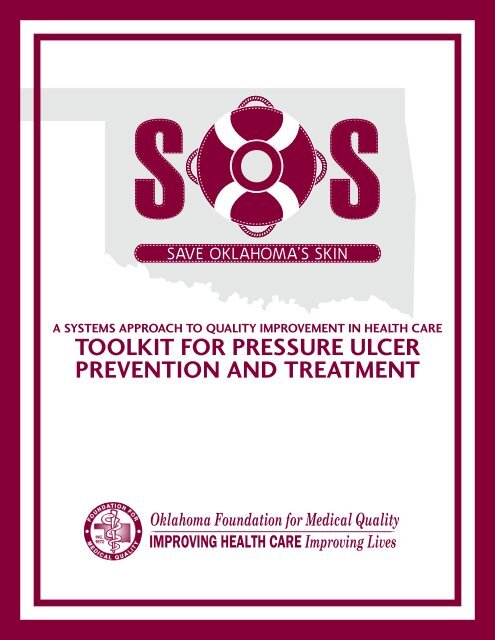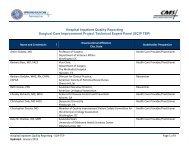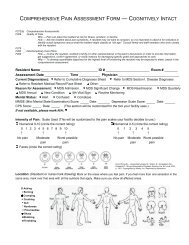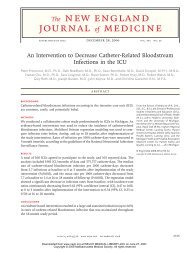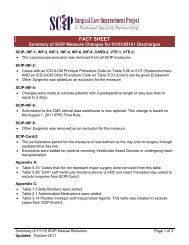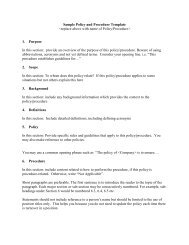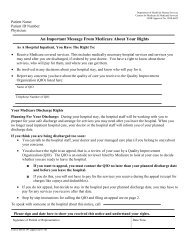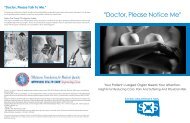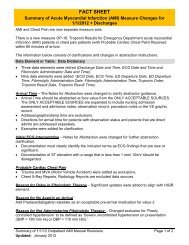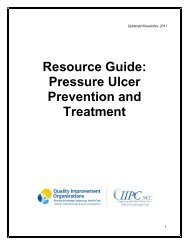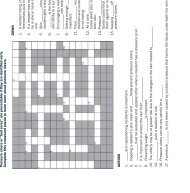toolkit for pressure ulcer prevention and treatment - Oklahoma ...
toolkit for pressure ulcer prevention and treatment - Oklahoma ...
toolkit for pressure ulcer prevention and treatment - Oklahoma ...
You also want an ePaper? Increase the reach of your titles
YUMPU automatically turns print PDFs into web optimized ePapers that Google loves.
SOSSAVE OKLAHOMA’S SKI NA Systems Approach to Quality Improvement in Health CareToolkit <strong>for</strong> Pressure UlcerPrevention <strong>and</strong> Treatment<strong>Oklahoma</strong> Foundation <strong>for</strong> Medical Qualityimproving health care Improving Lives
SOSSAVE OKLAHOMA’S SKI NA Systems Approach to Quality Improvement in Health Care:Toolkit <strong>for</strong> Pressure Ulcer Prevention <strong>and</strong> Treatment(Revision Date June 2009)IntroductionTable of ContentsPressure Ulcers OverviewSection 1Organizational Commitment <strong>and</strong> Policies <strong>for</strong> PressureUlcer Prevention <strong>and</strong> TreatmentSection 2Screening, Assessing <strong>and</strong> Monitoring Pressure UlcersSection 3Prevention <strong>and</strong> Treatment of Pressure UlcersSection 4Care Planning <strong>for</strong> Pressure UlcersSection 5Staff, Family <strong>and</strong> Patient/Resident EducationSection 6Transitions of CareAppendicesA Glossary of Pressure Ulcer TermsBPressure Ulcer GuidelinesCResourcesThis material was prepared by <strong>Oklahoma</strong> Foundation <strong>for</strong> Medical Quality, the Medicare Quality Improvement Organization <strong>for</strong> <strong>Oklahoma</strong>, under contract with theCenters <strong>for</strong> Medicare & Medicaid Services (CMS), an agency of the U.S. Department of Health <strong>and</strong> Human Services. The contents presented do not necessarily representCMS policy. 962-PU-856-0409Pressure Ulcer Prevention <strong>and</strong> Treatment (Rev 06/09)Page 2
OverviewPressure Ulcers: OverviewA <strong>pressure</strong> <strong>ulcer</strong> is localized injury to the skin <strong>and</strong>/orunderlying tissue usually over a bony prominence, asa result of <strong>pressure</strong>, or <strong>pressure</strong> in combination withshear <strong>and</strong>/or friction. A number of contributing orconfounding factors are associated with <strong>pressure</strong> <strong>ulcer</strong>s.(National Pressure Ulcer Advisory Panel (NPUAP),2007) The NPUAP developed a universal staging system<strong>for</strong> <strong>pressure</strong> <strong>ulcer</strong>s based on the depth <strong>and</strong> type of tissuedamage. This staging system is commonly used <strong>for</strong>assessment <strong>and</strong> care planning.The ProblemPressure <strong>ulcer</strong>s have been documented as a significantproblem across the lifespan <strong>and</strong> across all health caresettings, as well as a significant source of pain <strong>and</strong> humansuffering. The elderly may be at greater risk to develop<strong>pressure</strong> <strong>ulcer</strong>s due to the changes in the skin related toaging as well as the many co-morbidity factors present inthis population (Knox, et. al., 1994). Billions of dollarsare spent annually (Reddy, 2006) on the <strong>prevention</strong> <strong>and</strong><strong>treatment</strong> of <strong>pressure</strong> <strong>ulcer</strong>s, with the cost of treating one<strong>pressure</strong> <strong>ulcer</strong> ranging from $2000 to $30,000 <strong>and</strong> ashigh as $70,000. (Young, 2003)Pressure <strong>ulcer</strong>s are among the most common conditionsencountered in patients who are acutely hospitalized orrequire long-term institutional care. Critically ill patientsadmitted to intensive care units are at particularly highrisk of developing <strong>pressure</strong> <strong>ulcer</strong>s (de Latt, et. al., 2007).Two <strong>and</strong> a half million people in the U.S. develop a<strong>pressure</strong> <strong>ulcer</strong> in the acute care setting (IHI, 2007) <strong>and</strong>approximately 60,000 people die every year as a resultof complications from <strong>pressure</strong> <strong>ulcer</strong>s. (Nursing Center,2007)In addition, <strong>pressure</strong> <strong>ulcer</strong>s have been used as an indicatorof quality of care <strong>and</strong> their development has constitutedgrounds <strong>for</strong> litigation.The Centers <strong>for</strong> Medicare & Medicaid Services (CMS)has long focused on helping nursing homes prevent<strong>pressure</strong> <strong>ulcer</strong>s, <strong>and</strong> in 2008, they extended this ef<strong>for</strong>tacross health care settings. CMS recently increasedSOSSAVE OKLAHOMA’S SKI Nattention on multiple clinical topics, including theoccurrence of <strong>pressure</strong> <strong>ulcer</strong>s when patients move fromone health care setting to another.CMS data from 2007 to 2008 shows that overall,seven percent of <strong>Oklahoma</strong>’s nursing home residentsdeveloped a <strong>pressure</strong> <strong>ulcer</strong>. During this same time period,<strong>Oklahoma</strong> had the third highest rate of <strong>pressure</strong> <strong>ulcer</strong>s <strong>for</strong>high-risk residents in the nation.<strong>Oklahoma</strong> had the thirdhighest rate of <strong>pressure</strong><strong>ulcer</strong>s <strong>for</strong> high-riskresidents in the nation.Hospitalizations involving patients with <strong>pressure</strong> <strong>ulcer</strong>s—either developed be<strong>for</strong>e or after admission—increasedby nearly 80 percent between 1993 <strong>and</strong> 2006. Amonghospitalizations involving <strong>pressure</strong> <strong>ulcer</strong>s as a primarydiagnosis, about 1 in 25 admissions ended in death. Thedeath rate was higher when <strong>pressure</strong> <strong>ulcer</strong>s were a secondarydiagnosis—about 1 in 8. Pressure <strong>ulcer</strong>-relatedhospitalizations are longer <strong>and</strong> more expensive than manyother hospitalizations. While the overall average hospitalstay is 5 days <strong>and</strong> costs about $10,000, the average <strong>pressure</strong><strong>ulcer</strong>-related stay extends to between 13 <strong>and</strong> 14 days<strong>and</strong> costs between $16,755 <strong>and</strong> $20,430, depending onmedical circumstances. (AHRQ 2008)While the incidence of <strong>pressure</strong> <strong>ulcer</strong> occurrence inhospitals has not been previously reported, as of October,2008, CMS required hospitals to begin collecting <strong>and</strong>reporting this data. Additionally, CMS has provideda financial incentive to hospitals to prevent thedevelopment of <strong>pressure</strong> <strong>ulcer</strong>s.Diligent ef<strong>for</strong>ts of care givers can reduce <strong>pressure</strong> to bodyareas, however, there are some inherent characteristics(e.g., co-morbidities, high-risk diagnoses, immobility)that cannot be removed, changed or modified.Occasionally, these additional factors can make thedevelopment of certain <strong>pressure</strong> <strong>ulcer</strong>s unavoidable.This material was prepared by <strong>Oklahoma</strong> Foundation <strong>for</strong> Medical Quality, the Medicare Quality Improvement Organization <strong>for</strong> <strong>Oklahoma</strong>, under contract with theCenters <strong>for</strong> Medicare & Medicaid Services (CMS), an agency of the U.S. Department of Health <strong>and</strong> Human Services. The contents presented do not necessarily representCMS policy. 962-PU-856-0409Pressure Ulcer Prevention <strong>and</strong> Treatment (Rev 06/09)Page 4


